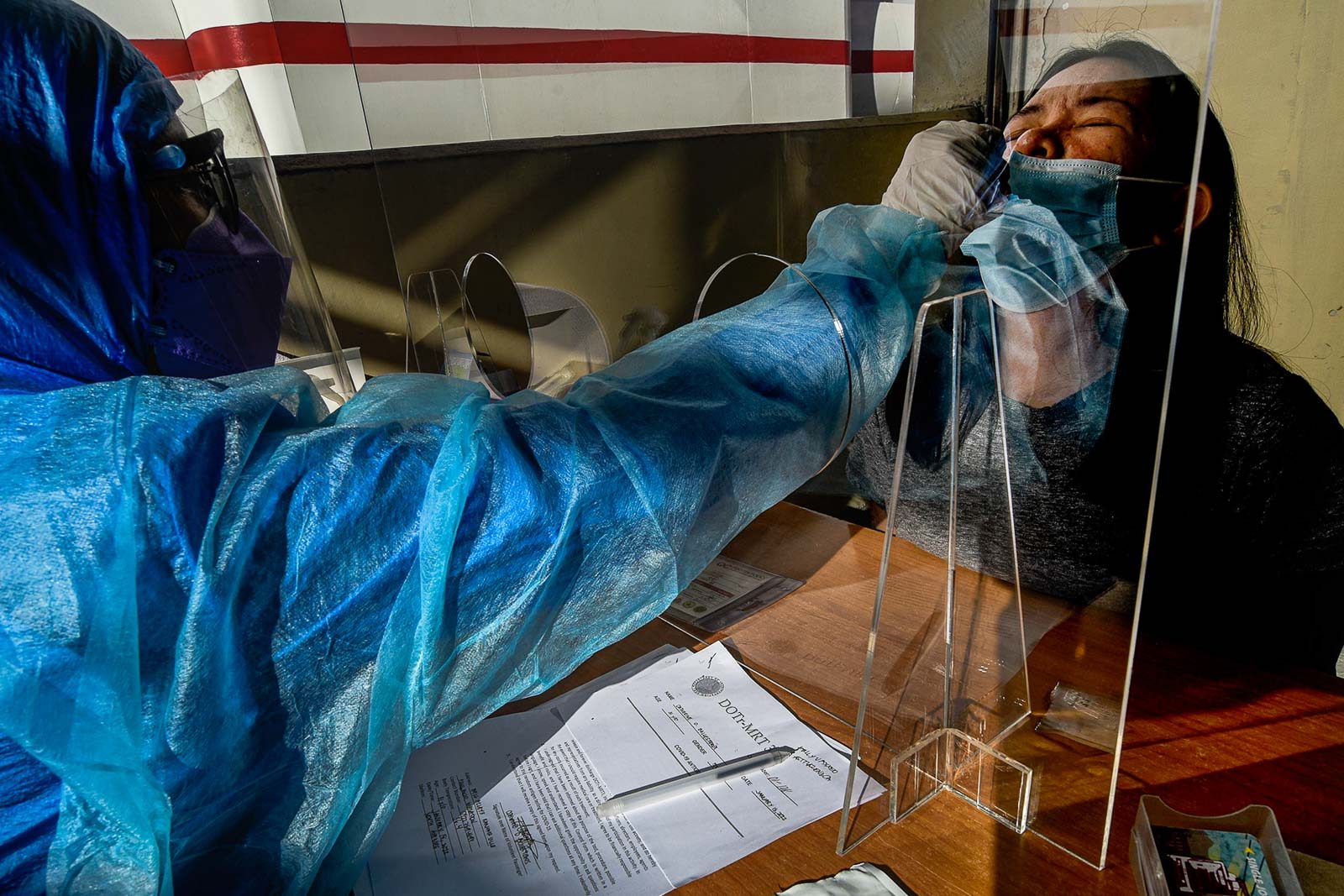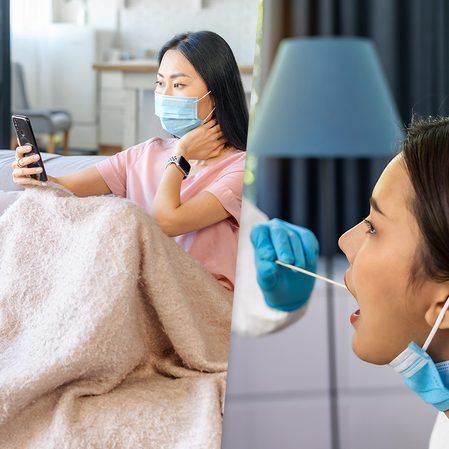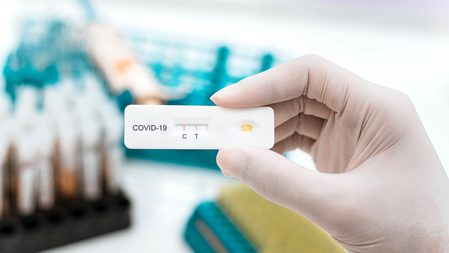SUMMARY
This is AI generated summarization, which may have errors. For context, always refer to the full article.

MANILA, Philippines – It was late Tuesday night of January 11, and 42-year-old Ryan Silverio had been trying to call clinics and laboratories so he could get himself tested for COVID-19. He was coughing, with a sore throat, and had developed fever that reached 38.5°C. None of the contact numbers he got from his friends could accommodate him.
“Ang dami kong tinawagan – sabihin na natin na 15 – pero wala talagang tumanggap. Lahat punuan. ‘Yung isang kilalang kilalang testing center, sinabi nila sa akin na they could accomodate me next week pa,” Silverio told Rappler in an interview on Wednesday, January 19.
(I contacted so many – maybe 15 testing centers – but none could accommodate me. All were full. A well-known testing center told me that they could accommodate me next week yet.)
After failed attempts, he sought help from their barangay health unit in Quezon City. That same night, their barangay office told him that healthcare workers would go to his place to get him tested. That happened, though, only after three more days and a followup call.
“Wednesday, nothing happened. Thursday, also nothing happened. I told them that I already had symptoms. But still, no one contacted me. At the same time, it was difficult to get access to home-serviced testing. That week was so tough,” Silverio said in a mix of English and Filipino.
On Friday, January 14, he finally got tested. As he suspected, he was positive for COVID-19.
Silverio was certainly not the only one scrambling for testing that week. Some 14 kilometers from Quezon City, 31-year-old Paola Alano in Antipolo City could not book an appointment – all the testing hubs she contacted were already overwhelmed. She had to look for other testing centers in nearby cities, until she found a drive-thru service in Marikina.
Alano told Rappler that it took her two hours to get tested. She estimated that the stretch of vehicles lined up for the drive-thru service was at 500 meters. After more than 24 hours, she received her results – positive for COVID-19.
Helpless, Filipinos took their frustrations online, lamenting how difficult it was to get tested for COVID-19 nearly two years into the pandemic. They were irked by how that Philippine government wasn’t able to strengthen its testing capacity, a basic component of any government’s pandemic response. (READ: Teleconsultation services, testing labs overwhelmed amid Omicron surge)
As the Philippines and the rest of the world were just recovering from the surge in infections driven by the Delta variant, they faced yet another, more transmissible, variant called Omicron, which is sweeping across the globe and driving a surge in infections in several countries. On January 15, COVID-19 cases in the Philippines reached a record high as 39,004 new cases were recorded. The country has recorded over 3.2 million cases of infections since the pandemic began.
Exposed: Gaps in government pandemic response
In an interview with Rappler on January 10, infectious disease specialist Dr. Rontgene Solante said that the fresh spike in cases had exposed the gaps in the country’s pandemic response, especially the government’s “inability to control the community transmission.”
He said spike in COVID-19 infections, especially in virus epicenter Metro Manila, was an “indication of massive and uncontrolled community transmission” of the highly contagious Omicron variant.
Solante said the Philippine government was quick to downgrade alert levels when the country was experiencing a downward trend in COVID-19 cases.
“We allowed early downgrading of the alert level when we saw cases going down at the expense of an imminent threat of an Omicron variant early December,” he said.
On January 11, the country’s COVID-19 positivity rate – the percentage of all COVID-19 tests performed that turn out positive – reached an all-time high at 47.98%, which meant nearly one in every two people tested turned out to be positive for the virus. The World Health Organization (WHO) has set a 5% positivity rate as benchmark for entering the new normal.
Professor Jomar Rabajante of the University of the Philippines pandemic response team told Rappler that a positivity rate nearing 50% means that “we need to detect more cases.”
“With near-50% positivity rate, active cases could be 10 times the reported cases,” he said. While testing capacity in the country has significantly improved since the pandemic began, Rabjante said, it should still be intensified and made more accessible to the public.
On January 12, the Philippines’ daily testing capacity was at its highest at 83,374 tests.
New testing protocol
Recognizing the country’s limited resources for COVID-19 testing, the Department of Health (DOH) revised its testing protocol, prioritizing testing for symptomatic patients and vulnerable groups, such as health workers, senior citizens, and individuals with comorbidities. (Learn more about the new testing protocol in this article.)
DOH technical adviser Edsel Salvana explained the logic behind the protocol, saying that many people in the country had already been vaccinated against COVID-19. The shift in testing protocol was in line with the DOH’s goal of improving the clinical management of cases.
“The most important action point is that there are many, many people who are already vaccinated, which means that if you are vaccinated and you’re not in the vulnerable population, most likely 99.9% of the time you will recover and you won’t require any antivirals and you won’t need to be hospitalized,” he said.
Dr. Beverly Ho, director of the DOH’s Health Promotion Bureau, echoed Salvana, saying, “We slowly move out of making sure we calculate every single COVID-19 case in the country, which we actually don’t do with other infectious diseases like influenza.”
Solante said that he agreed with the DOH proposal because “it’s better to prioritize the test for those vulnerable population who are at higher risk of getting severe infection and who know if they have COVID-19 [so] they can be closely monitored.”
“For those not under the vulnerable population, testing them will not give us additional benefit since most of them, if with COVID-19, are not risk for severe illness,” he explained.
The change in testing protocol came after the DOH rejected anew calls for mass testing, saying that it was not a “rational thing” to do.
The DOH said it would eventually veer away from reporting all detected COVID-19 infections as it plans to only report severe to critical cases in its daily case bulletin. The agency has yet to give specific details about this plan.
As cases again soar to unprecedented levels, calls for more accessible testing have intensified. Experts said that cases could be far higher that what’s being reported as there could be patients experiencing COVID-19 symptoms but remained untested due to testing’s hefty price tag.
While the government has already set a price cap on COVID-19 testing, it is still expensive for minimum wage earners. The price cap in private hubs has been set at P2,940 to P3,360; for public testing centers, P2,450 to P2,800.
Health Undersecretary Maria Rosario Vergeire said on Tuesday, January 18, that concerned government agencies were again reviewing prices of testing services as they hoped to set a new price cap.
What the gov’t can do: Approve home test kits
Rabajante said the problem with testing could have been solved even before the Omicron-fueled surge if the government was able to approve low-cost home test kits.
“Magandang point diyan ay sana noong nalaman na may Omicron, nag-approve na ang FDA (Food and Drug Administration) ng self-test kits,” he said. (It would be good to point out that when they first learned about Omicron, the FDA could have approved self-test kits.)
While the use of home test kits has been allowed in other countries, the kits are thriving in the black market in the Philippines. The DOH, though, cautioned the public against the use of unapproved test kits as it may lead to inaccurate results.
As of January 18, there are 11 pending applications for self-administered COVID-19 test kits with the FDA.
WHO Director General Tedros Adhanom Ghebreyesus said “this pandemic is nowhere near over.” Silverio and Alano could only hope for a better pandemic management from the Philippine government as the country enters the third year of battling the health crisis.
“It’s been almost two years. We deserve a better response than this,” said Alano. – Rappler.com
Add a comment
How does this make you feel?


There are no comments yet. Add your comment to start the conversation.